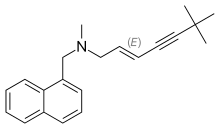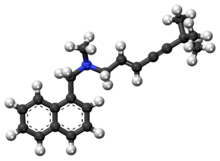Terbinafine
Terbinafine, sold under the brand name Lamisil among others, is an antifungal medication used to treat pityriasis versicolor, fungal nail infections, and ringworm including jock itch and athlete's foot.[1][2][3] It is either taken by mouth or applied to the skin as a cream or ointment.[1][4] The cream and ointment are not effective for nail infections.[5]
 | |
 | |
| Clinical data | |
|---|---|
| Trade names | Lamisil, others |
| AHFS/Drugs.com | Monograph |
| MedlinePlus | a699061 |
| License data |
|
| Pregnancy category |
|
| Routes of administration | By mouth, topical |
| ATC code | |
| Legal status | |
| Legal status | |
| Pharmacokinetic data | |
| Bioavailability | Readily absorbed: 70–90% |
| Protein binding | >99% |
| Metabolism | liver |
| Elimination half-life | Highly variable |
| Identifiers | |
| |
| CAS Number |
|
| PubChem CID | |
| DrugBank | |
| ChemSpider | |
| UNII | |
| KEGG | |
| ChEBI | |
| ChEMBL | |
| CompTox Dashboard (EPA) | |
| ECHA InfoCard | 100.119.605 |
| Chemical and physical data | |
| Formula | C21H25N |
| Molar mass | 291.438 g·mol−1 |
| 3D model (JSmol) | |
| |
| |
| | |
Common side effects when taken by mouth include nausea, diarrhea, headache, cough, rash, and elevated liver enzymes.[1] Severe side effects include liver problems and allergic reactions.[1] Liver injury is, however, unusual.[6] Use during pregnancy is not typically recommended.[1] The cream and ointment may result in itchiness but are generally well tolerated.[2] Terbinafine is in the allylamines family of medications.[1] It works by decreasing the ability of fungi to make sterols.[1] It appears to result in fungal cell death.[7]
Terbinafine was discovered in 1991.[8] It is on the World Health Organization's List of Essential Medicines.[4] In 2017, it was the 307th most commonly prescribed medication in the United States, with more than one million prescriptions.[9]
Medical uses
Terbinafine is mainly effective on the dermatophyte group of fungi.
As a cream or powder, it is used topically for superficial skin infections such as jock itch (tinea cruris), athlete's foot (tinea pedis), and other types of ringworm (tinea corporis).[10]
Tablets by mouth are often prescribed for the treatment of onychomycosis, a fungal nail infection, typically by a dermatophyte or Candida species. Fungal nail infections are located deep under the nail in the cuticle to which topically applied treatments are unable to penetrate in sufficient amounts. The tablets may, rarely, cause hepatotoxicity, so patients are warned of this and may be monitored with liver function tests. Alternatives to by mouth administration have been studied.
Terbinafine may induce or exacerbate subacute cutaneous lupus erythematosus. Persons with lupus erythematosus should first discuss possible risks with their doctor before initiation of therapy.[11]
Side effects
Many side effects and adverse drug reactions have been reported with oral terbinafine hydrochloride[12][13][14] possibly due to its extensive biodistribution and the often extended durations involved in antifungal treatment (longer than two months). A comprehensive list of adverse events associated with terbinafine use includes:
- Gastrointestinal problems: Diarrhea, constipation, nausea, fullness, abdominal pain, indigestion, dyspepsia, gastritis, cholestasis, flatulence, altered stool colour, abdominal muscular pain
- Central nervous system or neurological problems: Headaches, dizziness, vertigo, light-headedness, decreased concentration levels, paraesthesia (pins and needles)
- Hepatic problems: Raised liver enzyme levels, liver inflammation (hepatitis), liver damage, liver failure
- Immune system problems: Decreased white blood cell counts including pancytopenia, leukopenia, lymphopenia, thrombocytopenia, agranulocytosis, and neutropenia, autoimmune reactions such as lupus erythematosus
- Psychological problems: Depression, anxiety, insomnia, increased or unusual dream activity, malaise
- Sensory problems: Complete loss of taste (ageusia), decreased taste (hypogeusia) and distorted taste (dysgeusia), often involving a metallic taste sensation and dry mouth, visual disturbances including blurred vision, green vision and double vision. In extremely rare cases, the loss or impairment of taste is permanent [15]
- Skin problems: Rashes, hives (urticaria), skin irritation, itching, jaundice, Stevens–Johnson syndrome
- Other side effects: Fatigue, increased heart rate (tachycardia), hair loss (alopecia), decreased red blood cell count (anemia), muscle pain (myalgia), joint pain (arthralgia)
In 2015 physicians reported[16] that a patient with an MTHFR enzyme mutation (specifically the C677T variant) had developed an adverse reaction to Lamisil (headache, fatigue, and dizziness). Genetic testing revealed the MTHFR C677T mutation. It was noted that Lamisil interferes with the methylation cycle and that this can cause side effects in individuals with the MTHFR C677T mutation.
Pharmacology

Pharmacodynamics
Like other allylamines, terbinafine inhibits ergosterol synthesis by inhibiting squalene epoxidase, an enzyme that catalyzes the conversion of squalene to lanosterol. In fungi, lanosterol is then converted to ergosterol; in humans, lanosterol becomes cholesterol. However, there is sufficient genetic divergence between fungal and human squalene epoxidases that terbinafine preferentially binds fungal squalene epoxidase, making it selective for inhibiting ergosterol production in fungi without significantly affecting cholesterol production in humans. This is thought to change cell membrane permeability, causing fungal cell lysis.
Terbinafine is highly lipophilic and tends to accumulate in hair, skin, nails, and fatty tissue.
Chemistry
Terbinafine hydrochloride is a white fine crystalline powder that is freely soluble in methanol and dichloromethane, soluble in ethanol, and slightly soluble in water.
Terbinafine is produced from metathesis of 1,3-dichloropropene and neohexene followed by reaction with N-methyl-1-naphthalenemethanamine.
History
Terbinafine first became available in Europe in 1991 and in the United States in 1996. The U.S. Food and Drug Administration has approved the first generic versions of prescription Lamisil (terbinafine hydrochloride) tablets. The remaining patent or exclusivity for Lamisil expired on June 30, 2007.
On September 28, 2007, the FDA stated that terbinafine is a new treatment approved for use by children age four and up. The antifungal granules can be sprinkled on a child's food to treat ringworm of the scalp, tinea capitis.[17]
In the United States the price in 1999 was $547 for a 12-week course; this fell to $10 by 2015, after the patent had expired.[18]
Society and culture
Brand names
- Terbinafine is sold in India as Terboderm by Omega Pharma and Tyza (Abbott Healthcare).[19]
- Lamisil in Argentina, Australia, Bangladesh,[20] Belgium, Brazil, Canada, Chile, Colombia, Croatia, Egypt, the Czech Republic, Denmark, Estonia, Finland, France, Germany, Greece, Hungary, Iceland, Ireland, Israel, Mexico, the Netherlands, New Zealand, Norway, Pakistan (لیمسل), Peru, the Philippines,[21] Romania, Russia, Slovakia, Slovenia, South Africa, Sweden, Thailand, the United Kingdom, the United States, and Venezuela
- Corbinal and Terbisil in Turkey, Pakistan, Undofen in Poland, and Terbistad (Stada Arzneimittel).
- As a generic oral medication, it is sold as Sebifin, Tinasil, Terbisil, Terbicor, and Tamsil in Australia, whilst the generic topical medication is sold there as SolvEasyTinea and Tamsil.[22][23]
- It is also available as a generic medication in the United States, the United Kingdom, Belgium, Switzerland, Brazil and Mexico.
- In India, terbinafine hydrochloride is available in topical form under the brand names Triabin by Medley Pharmaceuticals, Sebifin (Sun Pharma), Zimig (GSK Pharma) and mycoCeaze (Progreś Laboratories). MycoVa, developed by Apricus Biosciences, is a topical nail solution of terbinafine and DDAIP, which has completed three phase-III studies for the treatment of onychomycosis.
- Other names include Terbinaforce (Mankind Pharma) and Tafine (Deurali Janta Pharmaceuticals Pvt Ltd.) Turbo (Apex Pharmaceuticals Pvt Ltd) in Nepal.
- The topical form is sold as Lamisil AT in the United States.
References
- "Terbinafine Hydrochloride". The American Society of Health-System Pharmacists. Archived from the original on 21 December 2016. Retrieved 8 December 2016.
- "Lamisil 1% w/w Cream – Summary of Product Characteristics (SPC) – (eMC)". electronic Medicines Compendium (eMC). 17 March 2016. Archived from the original on 20 December 2016. Retrieved 17 December 2016.
- Crawford, F (20 July 2009). "Athlete's foot". BMJ Clinical Evidence. 2009. PMC 2907807. PMID 21696646.
- World Health Organization (2019). World Health Organization model list of essential medicines: 21st list 2019. Geneva: World Health Organization. hdl:10665/325771. WHO/MVP/EMP/IAU/2019.06. License: CC BY-NC-SA 3.0 IGO.
- Hamilton R (2015). Tarascon Pocket Pharmacopoeia 2015 Deluxe Lab-Coat Edition. Jones & Bartlett Learning. p. 180. ISBN 978-1-284-05756-0.
- Yan, J; Wang, X; Chen, S (August 2014). "Systematic review of severe acute liver injury caused by terbinafine". International Journal of Clinical Pharmacy. 36 (4): 679–83. doi:10.1007/s11096-014-9969-y. PMID 24986266.
- "Terbinafine". www.drugbank.ca. Retrieved 2017-11-14.
- Ravina E (2011). The Evolution of Drug Discovery: From Traditional Medicines to Modern Drugs. John Wiley & Sons. p. 90. ISBN 978-3-527-32669-3. Archived from the original on 2016-12-20.
- "Terbinafine - Drug Usage Statistics". ClinCalc. Retrieved 11 April 2020.
- Markova T (January 2002). "Clinical inquiries. What is the most effective treatment for tinea pedis (athlete's foot)?". The Journal of Family Practice. Frontline Medical Communications. 51 (1): 15–22. PMID 11927056. Archived from the original on 2012-04-06.
- Callen JP, Hughes AP, Kulp-Shorten C (September 2001). "Subacute cutaneous lupus erythematosus induced or exacerbated by terbinafine: a report of 5 cases". Archives of Dermatology. 137 (9): 1196–8. doi:10.1001/archderm.137.9.1196. PMID 11559217.
- "Lamisil (terbinafine): Side Effects". Doublecheckmd.com. 2010-06-16. Archived from the original on 2013-09-21. Retrieved 2013-11-09.CS1 maint: BOT: original-url status unknown (link)
- McGuire S (2008-02-05). "Australian regulators issue warning on Novartis' Lamisil". Medical Marketing and Media. Mmm-online.com. Archived from the original on 2013-11-09. Retrieved 2013-11-09.
- "Terbinafine-1 (Terbinafine Hydrochloride, Lamisil)". Drug Dosage and Side Effects. Healthline.com. 2009-02-27. Archived from the original on 2013-11-09. Retrieved 2013-11-09.
- Duxbury AJ, Oliver RJ, Pemberton MN (March 2000). "Persistent impairment of taste associated with terbinafine". British Dental Journal. 188 (6): 295–6. doi:10.1038/sj.bdj.4800461. PMID 10800234.
Persistent loss of taste associated with terbinafine would however appear to be extremely rare.
- Trachtman JN, Pagano V (December 2015). "Antifolates and MTHFR". Therapeutic Drug Monitoring. 37 (6): 697–8. doi:10.1097/FTD.0000000000000215. PMID 25929315.
- "US FDA approves oral granules for scalp ringworm". Reuters. 2007-09-28. Archived from the original on 2009-03-23.
- Mikailov A, Cohen J, Joyce C, Mostaghimi A (2015). "Cost-effectiveness of Confirmatory Testing Before Treatment of Onychomycosis". JAMA Dermatology. 152 (3): 1–6. doi:10.1001/jamadermatol.2015.4190. PMID 26716567.
- "Terbinafine brands in India". Brand index. DrugsUpdate India. Archived from the original on 2015-09-23.
- "Lamisil". Medex.com.bd. Archived from the original on 2019-01-19. Retrieved January 17, 2019.
- "Mercury Drug – The Leading Drugstore in the Philippines". www.mercurydrug.com. Archived from the original on 2016-11-18. Retrieved 2016-11-18.
- "Terbinafine". Pharmaceutical Benefits Scheme: A-Z list. Australian Government. Archived from the original on 2014-02-12.
- "PI and CMI Trade Names and Active Ingredients containing Terbinafine". Therapeutic Goods Administration. Australian Government. Archived from the original on 2017-09-10.
External links
- "Terbinafine". Drug Information Portal. U.S. National Library of Medicine.